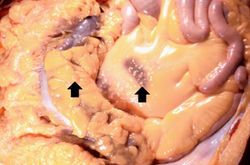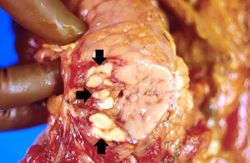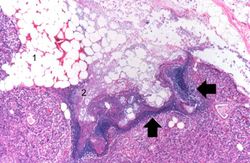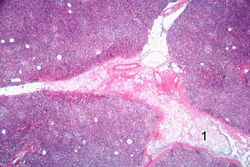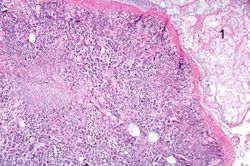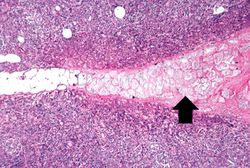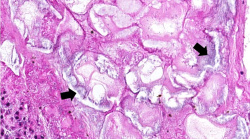Difference between revisions of "IPLab:Lab 1:Fat Necrosis"
(→Images) |
(→Images) |
||
| Line 8: | Line 8: | ||
File:IPLab1FatNecrosis1.jpg|This gross photograph shows the intestines and omentum at autopsy. Note the small (5-15 mm in diameter) white nodules on the surface of the omental and mesenteric fat tissue (arrows). | File:IPLab1FatNecrosis1.jpg|This gross photograph shows the intestines and omentum at autopsy. Note the small (5-15 mm in diameter) white nodules on the surface of the omental and mesenteric fat tissue (arrows). | ||
File:IPLab1FatNecrosis2.jpg|This gross photograph of the pancreas from this case shows white nodules (arrows) in the pancreas and the adjacent mesenteric fat tissue. | File:IPLab1FatNecrosis2.jpg|This gross photograph of the pancreas from this case shows white nodules (arrows) in the pancreas and the adjacent mesenteric fat tissue. | ||
| − | File:IPLab1FatNecrosis3.jpg|This low-power photomicrograph of the pancreas from this case shows the fat tissue (1) surrounding the pancreas. Note the rim of inflammatory cells (arrows) and the blue areas | + | File:IPLab1FatNecrosis3.jpg|This low-power photomicrograph of the pancreas from this case shows the fat tissue (1) surrounding the pancreas. Note the rim of inflammatory cells (arrows) and the blue areas that represent calcified fat adjacent to the pancreas (2). |
| − | |||
File:IPLab1FatNecrosis5.jpg|Another high-power photomicrograph shows blue discoloration in the fat tissue in the interlobular spaces (1) of the pancreas. | File:IPLab1FatNecrosis5.jpg|Another high-power photomicrograph shows blue discoloration in the fat tissue in the interlobular spaces (1) of the pancreas. | ||
File:IPLab1FatNecrosis6.jpg|A higher-power photomicrograph of the previous slide contains a small area of fat necrosis (1) in the upper right portion of the image. The fat necrosis is within the fat tissue that is normally found adjacent to the pancreas. The appearance of the pancreatic tissue in this area is somewhat disrupted due to autolysis (the pancreas autolyzes very rapidly after death) but there is some premortem necrosis as well. | File:IPLab1FatNecrosis6.jpg|A higher-power photomicrograph of the previous slide contains a small area of fat necrosis (1) in the upper right portion of the image. The fat necrosis is within the fat tissue that is normally found adjacent to the pancreas. The appearance of the pancreatic tissue in this area is somewhat disrupted due to autolysis (the pancreas autolyzes very rapidly after death) but there is some premortem necrosis as well. | ||
Revision as of 18:28, 1 August 2019
Contents
Clinical Summary[edit]
This was a 37-year-old female with chronic renal failure who underwent a cadaveric renal transplant. Following transplantation she developed oral candidiasis, pneumonia, pyuria, and gastrointestinal bleeding. Subsequently, the patient became septic and died.
Major findings at autopsy included extensive hemorrhagic bronchopneumonia and multiple ulcers affecting the stomach and esophagus. There was also evidence of disseminated intravascular coagulation (DIC) with multiple hemorrhages present. Firm, whitish foci of necrotic tissue were found in the fat around the pancreas.
Images[edit]
A higher-power photomicrograph of the previous slide contains a small area of fat necrosis (1) in the upper right portion of the image. The fat necrosis is within the fat tissue that is normally found adjacent to the pancreas. The appearance of the pancreatic tissue in this area is somewhat disrupted due to autolysis (the pancreas autolyzes very rapidly after death) but there is some premortem necrosis as well.
This high-power photomicrograph demonstrates fat necrosis in the interlobular spaces of the pancreas. Note the granular blue-staining calcium deposits (arrows) within the fat cells. The clear areas represent artifact caused by the "washing-out" of fat from cells during tissue processing for histology.
Virtual Microscopy[edit]
Pancreatic Fat Necrosis[edit]
Normal Pancreas[edit]
Study Questions[edit]
Additional Resources[edit]
Reference[edit]
Journal Articles[edit]
- Forsmark CE, Vege SS, Wilcox CM. Acute Pericarditis. N Engl J Med" 2016; 375:1972-1981. November 17, 2016.
- LeWinter MM. Acute Pericarditis. NEJM 2014 Dec 18;371:2410-2416.
Images[edit]
| |||||
Renal failure is the severe reduction of renal function and often leads to reduced urinary output.
Candidiasis is an infection by the fungus Candida in the oral cavity.
In alcoholics, aspiration pneumonia is common--bacteria enter the lung via aspiration of gastric contents.
Pyuria is the presence of white blood cells (pus) in the urine.
Sepsis is the presence and persistence of pathogenic microorganisms and their toxins in the blood.
DIC is the development of small thrombi within the microcirculation throughout the body.
